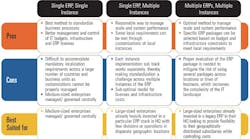Hub-and-Spoke ERP Model Drives Efficiency in Large Enterprises
Globally expanding enterprises often have units working in silos using business processes that are not standardized across the organization. To ensure business efficiency, large multinational enterprises need a robust Enterprise Resource Planning (ERP) solution that preserves a desired degree of enterprise diversity while cohesively managing units across geographies through process harmonization.
The two-tier ERP model, also known as the hub-and-spoke model, has several features that enable large enterprises to integrate their global and local business processes. This article outlines a successful implementation strategy to deploy ERP solutions across individual business units. It also discusses a framework to select the best-suited hub-and-spoke ERP and best practices to ensure a smooth implementation. Such a strategy can enable multi-instance ERP solutions, thereby driving business process efficiencies, improving competitiveness and lowering costs.
Enterprises are expanding their global footprint, stepping over country borders and across continents to embrace new opportunities emerging around the world. As they seal merger and acquisition deals, set up joint ventures, build new factories, setup sales and operation centers, and create new distribution channels, the enterprise structure becomes ever more complex and business processes lose the vital element of standardization. Using accepted in-house processes, each unit or division evolves its own ways of doing business, which can happen owing to any of the following reasons:
- Local laws and regulations need the businesses to operate in a particular way, report in specific formats, etc.
- Businesses attribute their competitive edge in the market to certain business processes they may have adopted.
- The current processes may have been in place for a long time and nobody has yet taken the time or effort to improve the process.
However, the benefits of expansion come to naught if all business units do not operate in a harmonized manner. For example, if the local entity follows a widely different process for procurement or financial management, they will always continue to run as a separate unit and can never get integrated into the larger enterprise. A common enterprise-wide ERP platform across geographies and business divisions standardizes business processes and ensures unison in functioning, which improves efficiency through adoption of best practices. When rolling out an ERP application, the above-mentioned local process specificities and inefficiencies must be confronted and overcome. This is no easy battle, neither for the enterprise itself nor for the systems integration partner.
Best Strategy for ERP Deployment
This article is an attempt to help ERP practitioners work through the enterprise maze and devise appropriate strategies for ERP deployment. The idea is to implement efficient processes based on standard ERP packages while not compromising excessively on the need for localization. In such a scenario, practitioners must address some key questions, such as:
- Is it more cost effective to create a single ERP instance for all users across functions, divisions and geographies?
- Must a multi-instance strategy be adopted for the same ERP solution where different instances cater to different divisions, lines of business or geographies?
- Should multiple ERP solutions (from different vendors) and instances be adopted to cater to the particular needs and specificities of each line of business or country requirements?
Choosing the right deployment strategy is not simple. Though each option has its own advantages, each comes with its own bag of complexities. Let us analyze the advantages and disadvantages of each to understand which approach is best suited in specific situations. These situations refer to:
- Corporate structure (eg. centralized versus decentralized governance.)
- Business needs and priorities including timeline constraints that drive the ERP implementation
- Existing IT landscape including legacy Line of Business (LoB) applications
- Organizational change management challenges
- Corporate IT strategies and long-term roadmap for optimizing software licenses and hardware costs
- Maturity of IT organization and infrastructure in the headquarters (HQ) and distribution units
- Availability and extent of budgets for the ERP solution
While the above table provides some guidance on choosing the best-suited ERP approach, it is not prudent for large multinational enterprises however to adopt a plethora of ERP applications and instances for effective management of their multiple LoBs and subsidiaries. However, there is a method to this madness, a way to cut through the chaos and implement multiple instances of ERP(s) and yet achieve broad harmonization of business processes while allowing subsidiaries to have some leeway in localizing to meet specific needs. This model of ERP deployment and rollout is popularly known as the 'Hub and Spoke model' or the 'Two Tier ERP model.'
Let us consider some of the challenges enterprises face while adopting a multi-instance ERP implementation strategy, and then explore the framework to select the best-suited hub-and-spoke ERP solutions components and the implementation/rollout strategy. In the end, we can look at some tips to ensure a smooth and predictable hub-and-spoke ERP implementation.
Multi-instance ERP Implementation Challenges
The key challenges any enterprise faces while adopting a multi-instance ERP strategy are:
- Lack of Standardization of Business Processes Deploying multiple ERP instances to manage different operations in different geographies or business units can severely compromise standardization. Such a situation, if not managed well, can rapidly lead to stakeholders of each ERP instance running their own versions of the business practices with possible over customizations that are incongruent with the headquarters or that are not the current standard. This can severely limit business efficiencies and create fragmented IT systems. For instance, a subsidiary that implements a procurement process that is different from the one used by the HQ, reduces process synergy. It becomes difficult to deploy an integrated procurement framework and set of business rules across multiple business units to leverage economies of scale to lower procurement costs.
- Increase in IT Infrastructure Costs Multi-instance deployment can increase incurred costs for hardware and software licenses. Typically, ERP software is licensed by the number of users per site along with fixed base costs. In a multi-instance scenario, these costs are multiplied due to software licensing, annual maintenance as well as the hardware boxes needed to support the different instances. Additional costs arise from hardware and software needs for individual development and test instances.
- Increase in the Need for Diverse Skill-sets In a multi-instance scenario, local IT departments require a diverse set of technology skills to maintain the different ERP instances and integrate them with other legacy applications, which can be a strain on small IT teams. Typically the deficit of required skills necessitates dependence on multiple external system integrator vendors, thereby leading to additional application maintenance overheads and costs.
- Master Data Management Challenges With data in the enterprise spread across multiple IT systems and ERP solutions, the cleanliness of data and the concept of a 'single source of truth' takes a beating. The challenges of effective data maintenance increase, and enterprises seeking to overcome this challenge would need to employ enterprise data warehouses and data marts.
Selection Framework
Enterprises must consider the above challenges when deciding how to implement multi-instance ERP to maintain organizational diversity. However, deciding the right ERP solution at the 'spoke' level i.e., at the individual business entity/subsidiary level, is more complex. It requires deep understanding of enterprise-wide and local needs such as process details, adequate process coverage, minimal demands on IT infrastructure and skill-sets, and cost-effectiveness.
In most cases the best choice for the spoke ERP solution lies outside traditional legacy ERP solutions. Large, reliable ERP vendors often provide the 'lower complexity' ERP or spoke ERP solutions that are simple, easy to use and yet functionally rich. Some of the features that characterize these small footprint ERP solutions, thereby making them the optimum choice, are:
- Provides integrated functionality with reasonable depth across General Ledger, Accounts Payable, Accounts Receivable, Fixed Assets, Sales, Purchases, Inventory, Production, Human Resources, etc.
- Ensures optimum horizontal functioning i.e., it can be deployed in most industry verticals
- Employs a simple user interface to facilitate easy training for end-users
- Ensures that there is low requirement for new IT infrastructure and IT skills for deployment and maintenance, thereby enabling low total cost of operation.
- Provides seamless integration capabilities with legacy applications as well as office productivity tools, email servers, workflow, data warehouses, and portals
- Has the scalability and flexibility to support the enterprise through required version and technology upgrades for the foreseeable future
Best Practices for a Smooth Hub-and-spoke ERP Implementation
After selecting the right ERP solution for the smaller business units or spokes, enterprises must focus on adopting certain measures to realize the true benefits of the hub-and-spoke model for ERP deployment. To achieve the overarching goals of process standardization across the enterprise, cost reduction, simplification of the IT infrastructure, and better management of master data, Infosys suggests the following best practices to follow in various key areas:
- Selection of the Implementation Partner Selecting the right system integrator (SI) partner for ERP implementation is crucial. While quality, experience and credentials command a premium, they can go a long in ensuring the project's success. Typically, a global SI with experience in rolling out large ERP packages is best suited for a hub-and-spoke deployment when compared to local vendors or boutique consulting setups. For two-tier ERP deployment, the ERP solution at the spoke may be smaller and easier to implement. However a large global SI provides other services that can have a visible impact. Their inputs would include:
- Best practices for process standardization and simplification of the IT infrastructure
- Skill-sets to modify multiple legacy packages and the 'hub' ERP solution
- Integration of multiple systems providing for better business process orchestration and master data management
- Enabling organizational change management
Rising IT and business expectations for a more standardized and integrated operations have accelerated the two-tier ERP model to be successfully deployed and implemented at various global enterprises. Enterprises need to be simplified, whether in terms of business processes or IT infrastructure, and this is best achieved by a simplified ERP deployment solution. The two-tier ERP model provides great benefits to the enterprise by ensuring simplicity and operational cost-efficiency . If designed well, the smaller ERP solution deployed at the enterprise's periphery can provide local business with the autonomy and localization it needs even as they enjoy the benefits of being integrated into the larger enterprise through commonality of data and standardization of processes.
Conclusion
Enterprises seeking to expand their business and retain their competitive edge must overcome process disparity in various subsidiaries/business units. To standardize processes and overcome existing inefficiencies, enterprises require a robust Enterprise Resource Planning (ERP) package with well planned deployment model, that can ensure global process standards as well as meet local needs.
When enterprises choose a two-tier model of ERP implementation, it enables enterprises to cater to both the HQ level ambitions and local level needs. The the hub-and-spoke model facilitates seamless integration of business process, ensures business scalability and reduces operational and maintenance costs.
Dinesh Mohan is the Industry Principal with Enterprise Solutions at Infosys Technologies Ltd., which defines, designs and delivers IT-enabled business solutions.
Interested in information related to this topic? Subscribe to our Information Technology eNewsletter.




